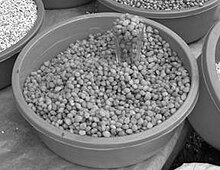Njangsa
| Njangsa | |
|---|---|
 |
|
| Njansang is widely traded in Central and West Africa | |
| Scientific classification | |
| Kingdom: | Plantae |
| (unranked): | Angiosperms |
| (unranked): | Eudicots |
| (unranked): | Rosids |
| Order: | Malpighiales |
| Family: | Euphorbiaceae |
| Subfamily: | Crotonoideae |
| Tribe: | Ricinodendreae |
| Genus: | Ricinodendron |
| Species: | R. heudelotii |
| Binomial name | |
|
Ricinodendron heudelotii (Baill.) Heckel |
|
| Subspecies | |
R. heudelotii heudelotii
R. heudelotii africanum
The term Njangsa refers to an oily seeds tree, Ricinodendron heudelotii, found in tropical West Africa. It is also known as Munguella (Angola), Essessang (Cameroon), Bofeko (Zaire), Wama (Ghana), Okhuen (Nigeria), Kishongo (Uganda), Akpi (Cote d'Ivoire), Djansang, Essang, Ezezang and Njasang. Two varieties of the tree species are recognized R. heudelotii var. heudelotii in Ghana and R. heudelotii var. africanum in Nigeria and Westwards.
The tree is fast growing and reaches a height between 20 and 50 m with straight trunk which can have a diameter up to 2.7 m. His crown is broad and the roots are big running. The bark is smooth with a grey color. Inside, the bark is red when cut.
Njangsa is a dioecic plant. The flowers are yellowish white, 5 mm long and form a long terminal panicle which measures between 15 and 40 cm. Flowering time is between April and May. Male panicles are larger and slender than female flowers.
Njangsa trees produce a fruit that are typically 2-3 lobed and contain 2 cells in which the seeds lie. These seeds are red-brown to black in colour, rounded and some 1 cm in diameter. The seeds are oily in texture and can be bought either raw or dried. They have an odour reminiscent of oily chocolate, but their flavour is truly unique: subtly aromatic with a mild bitter aftertaste. At maturity (August - September) the fruit smells like over-ripe apples.
Njangsa is endemic to Tropical Africa. The native geographic location of Njangsa reaches from Senegal in West Africa to Sudan, Uganda, and Tanzania, and from Sudan down to the western coast of Sub-Saharan Africa to Angola. The tree is also found in Madacascar.
Njangsa grows generally in rain forests and is also typical for secondary forests. This tree is a light-demanding species. Therefore, it can also be found in deciduous forests, forest edges, secondary scrubs and thickets in semi-dry savannahs. The tree is observed in food crop fields, cocoa farms and other agroforestry systems, where the trees can also intentionally be planted.
...
Wikipedia
